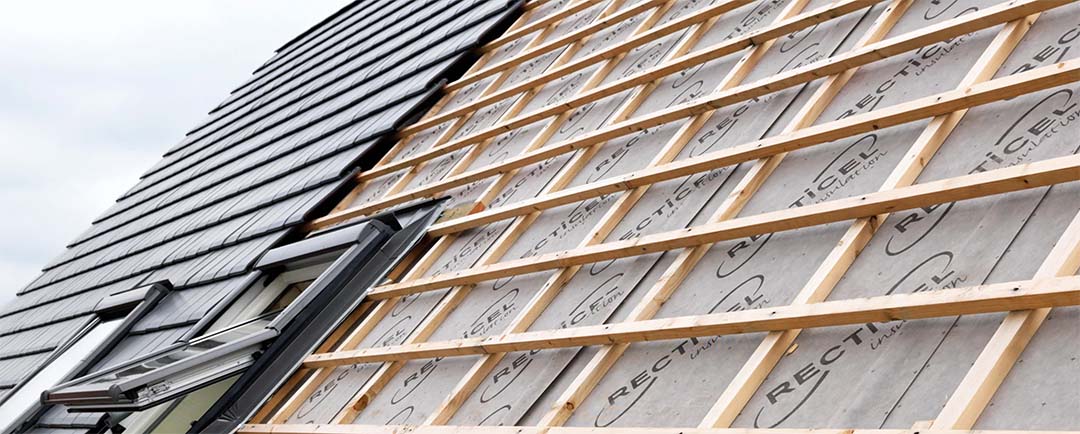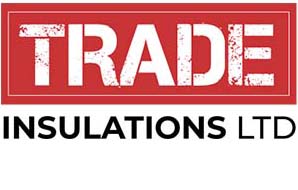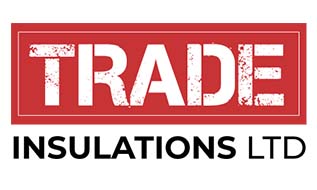Who are Recticel?
Recticel serves mainly in Europe but is internationally known and is active in the USA and Asia.
Recticel’s Insulation business line is the heart of the Recticel Group and has over 60 years of experience, the company has become a well know and admired brand when it comes to insulation and continues to grow. Recticel develops high-performance insulation and solutions when it comes to thermal and acoustic applications in the building and architectural market.

What are Recticel Boards Made From?
PIR is a thermoset polymeric material that blends isocyanates and polyols. The manufacturing method creates a chemical reaction that produces a robust, rigid material that makes up the core of the material and does not melt when heated. This is also known as Polyisocyanurate (PIR).
The polyisocyanurate (PIR) board is then bonded with a layer of low emissivity foil to create foil facings on each side to improve thermal quality by storing and increasing heat within the board.
The foil facing can also be used to reflect heat and keep it within a specific area, such as when PIR boards are installed into the ceiling the foil reflects the heat back into the building and begins to heat the property from the ceiling down.
Recticel Insulation Benefits
- PIR is cost effective; you can save up to 30% of your annual energy bills.
- It will make your property a more comfortable environment by providing better temperature control.
- It will achieve temperature control by keeping the heat out in the summer and the cold out in the winter as well as maintaining the temperature within the property.
- It will make your property a more sustainable environment and more energy efficient.
- It makes your home more energy efficient by keeping the heat in your home which will help prevent climate change and global warming.
- Specific insulation materials can suit needs such as moisture resistance, sound proofing and fire resistance
- The correct insulation installed properly can increase the life span of the building and the insulation can last for as long as the building does.
All Recticel insulation board can be cut by:
- Scoring one side of the board with a sharp blade, snapping over a hard edge, and then scoring the other side.
- Measure and mark the board. Place the board over a surface edge with room for the saw to cut through. Use a fine-toothed saw to cut.
How to store an insulation board:
Insulation boards should be stored stacked on a flat surface with no excess pressure on the boards. If indoor storage is not an option, the correct weatherproofing materials should be used to cover the boards. Although rigid, the boards should not be walked on until installed as they may crumble or snap.
Floor Insulation:
Recticel boards are known for their impressive compression strength making them the perfect insulation materials for areas that need to withstand heavy loads such as floors including, below concrete slabs, below screed, below floating timber floors, suspended block and beam, and between joists.
Before you begin insulating your home:
- Please note this is only a guide and a professional builder should be consulted before any insulation works are started on your home / property.
- Make sure your home / property is in the correct condition to have insulation installed. Insulation should not be applied to damaged walls, rotted wood or walls containing damp. This could worsen the condition, so it is important any problems are treated first.
- Insulating your home correctly can save money on your energy bills and make your home more energy efficient. By making your home more energy efficient you are helping to prevent climate change and global warming.
Recticel Products
Recticel Eurothane GP PIR Insulation Boards
Material: Polyisocyanurate (PIR), Low emissivity foil
Size: 2400mm x 1200mm
Thicknesses: 25mm – 150mm
Thermal Conductivity: 0.022W/mK
Applications include:
- Wall insulation – masonry walls, timber frame walls,
- Roof insulation – between and under rafters
- Floor insulation – suspended timber floors.
How to install –
PIR Insulation boards can be installed in numerous ways. The most common method is to simply cut the board to size and fit into the relevant cavity such as between the rafters or within a wall stud. The insulation should be taped when butted together and secured by overlaying with another later of insulation followed by plasterboard or insulated plasterboard completed with the necessary fixings.
Recticel Eurowall Cavity Wall Board
Material: Polyisocyanurate (PIR), Low emissivity foil
Size: 1200mm x 450mm
Thicknesses: 30mm x 100mm
Thermal Conductivity: 0.022W/mK
Applications include:
- Partial fill cavity wall applications
- Pitched frame wall applications
- Rendered Dense Block and Block Cavity Wall applications
- Brick And Block Cavity Wall applications
How to install –
Cavity wall boards are installed in between the inner and outer leaf of the buildings structure as it is being built. The inner leaf (block work) is built up and the cavity boards are then fixed to the inner leaf with wall ties. Boards tightly butted and break bond patterned. The outer leaf (brick work) is then built up to just below the insulations top. The process is then repeated.
Recticel Eurowall+
Material: Polyisocyanurate (PIR), Low emissivity foil
Size: 1190mm x 450mm (1200mm x 460mm including tongue and groove joint)
Thicknesses: 75mm – 140mm
Thermal Conductivity: 0.022W/mK
Applications include:
- Full fill cavity wall applications
- Brick And Block Cavity Wall applications
- Rendered Dense Block and Block Cavity Wall applications
How to install –
Cavity wall boards are installed in between the inner and outer leaf of the buildings structure as it is being built. The inner leaf (block work) is built up and the cavity boards are then fixed to the inner leaf with wall ties. Boards are fitted with the tongue and groove edges interlocking in a break bond patterned with any cut boards tightly butted together. The outer leaf (brick work) is then built up to just below the insulations top. The process is then repeated.
Recticel Eurodeck Flat Roof
Material: Polyisocyanurate (PIR), Low emissivity foil
Size: 2400mm x 1200mm
Thicknesses: 25mm x 160mm
Thermal Conductivity: 0.022W/mK
Applications include:
- Warm Flat Roof applications
- Mechanically fixed single ply membrane systems
- Timber Deck applications
- Metal and concrete deck applications
How to install –
Ensure the flat roof is prepped before installing the insulation, this includes a VCL, adhesives, Felt, Etc.. Install the Eurodeck boards lightly butted in a brick bond pattern, with the long edges at right angles to the edge of the roof or laid diagonally across the deck. On a metal deck, the long edges should be at right angles to the troughs to ensure the short ends are fully supported or laid diagonally across the deck corrugations. Secure with the correct fixings and waterproofing materials.
Recticel Powerdeck F
Material: Polyisocyanurate (PIR), Mineral Glass Fleece
Size: 1200mm x 600mm
Thicknesses: 25mm – 150mm
Thermal Conductivity: 0.024 – 0.026W/mK
Applications include:
- Warm Flat Roof applications
- Mastic asphalt, single ply membrane, and built-up felt waterproofing systems
- Timber Deck applications
- Metal and concrete deck applications
How to install –
Ensure the flat roof is prepped before installing the insulation, this includes a VCL, adhesives, Felt, Etc.. Install the Powerdeck F boards lightly butted in a brick bond pattern, with the long edges at right angles to the edge of the roof or laid diagonally across the deck. On a metal deck, the long edges should be at right angles to the troughs to ensure the short ends are fully supported or laid diagonally across the deck corrugations. Secure with the correct fixings and waterproofing materials.
Recticel Powerdeck U
Material: Polyisocyanurate (PIR), Bituminous Glass Fleece
Size: 1200mm x 600mm
Thicknesses: 30mm – 150mm
Thermal Conductivity: 0.024 – 0.026W/mK
Applications include:
- Warm Flat Roof applications
- Torch-on and built-up waterproofing systems
- Timber Deck applications
- Metal and concrete deck applications
How to install –
Ensure the flat roof is prepped before installing the insulation, this includes a VCL, adhesives, Felt, Etc.. Install the Powerdeck F boards lightly butted in a brick bond pattern, with the long edges at right angles to the edge of the roof or laid diagonally across the deck. On a metal deck, the long edges should be at right angles to the troughs to ensure the short ends are fully supported or laid diagonally across the deck corrugations. Secure with the correct fixings and waterproofing materials. This board is compatible with bituminous torch-on felt waterproofing systems.
What is the different between Eurowall and Eurowall Plus?
Eurowall is 1200mm x 450mm and has a straight edge with a range of thicknesses from 30mm to 100mm. Eurowall is design for partial fill masonry wall applications.
Eurowall Plus is 1190mm x 445mm (1200mm x 460mm including edge joint) and has a tongue and groove edge with a range of thicknesses between 75mm and 140mm. Eurowall plus is designed for full fill masonry wall applications.
What is the different between Powerdeck F and Powerdeck U?
Both boards are design for warm flat roof applications and come in sizes of 1200mm by 600mm with thicknesses ranging from 25mm to 150mm. The difference within the board is that the Powerdeck F has a Mineral coated glass fleece facing on each side and the Powerdeck U has a Bituminous coated glass fleece facing on each side. The Powerdeck F has an additional board thickness of 25mm however the Powerdeck U starts from 30mm.

